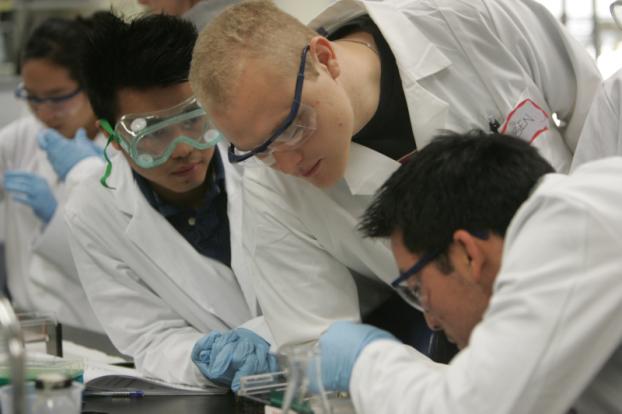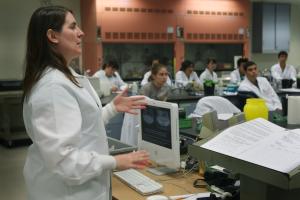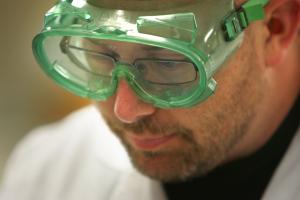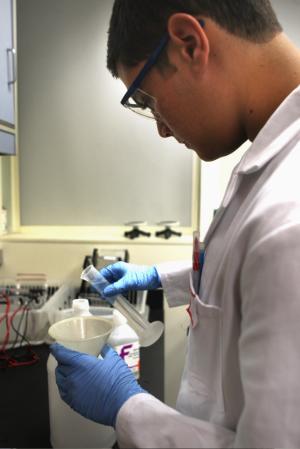 Caption: Graduate assistant Ben Smyth helps Santa Ana College student Long Lo, left, and Fullerton College student Bennett Cho prepare to separate DNA from cells during the Howard Hughes Medical Institute Weekend Research Experience held last month in Dan Black Hall. Lo and Cho were among nearly 30 high school and community college students and teachers to take part in the two-weekend program. Photo by Karen TapiaDownload Photo
Caption: Graduate assistant Ben Smyth helps Santa Ana College student Long Lo, left, and Fullerton College student Bennett Cho prepare to separate DNA from cells during the Howard Hughes Medical Institute Weekend Research Experience held last month in Dan Black Hall. Lo and Cho were among nearly 30 high school and community college students and teachers to take part in the two-weekend program. Photo by Karen TapiaDownload Photo
Exploring the Wonder of Scientific Research
Students, Teachers Study Plant DNA in Weekend Program
Nearly 30 high school and community college students and teachers converged on campus last month to explore the genetics behind plants’ resistance to diseases by using some of the most current techniques and technology. The weekend findings became part of a faculty research project.
Participants had interest and aptitude, but most had no research experience, just “cookbook” style of step-by-step instructional lab work to familiarize them with basic equipment and procedures.
But the research was secondary, anyway. Igniting enthusiasm was the goal.
"This was to show them the fascination of scientific research, as well as how we can use technology to understand nature’s secrets,” said Melanie Sacco, assistant professor of biological science, data beneficiary and organizer of this year’s Howard Hughes Medical Institute Weekend Research Experience. The event demonstrated, she said, the processes to scientific discovery and that the participants could do it.
 Caption: Biologist Melanie Sacco explains the electrophoresis process to participants before experiments begin. Photo by Karen TapiaDownload Photo
Caption: Biologist Melanie Sacco explains the electrophoresis process to participants before experiments begin. Photo by Karen TapiaDownload Photo
The weekend research was designed to show how researchers can connect disease resistance with genetic information in a plant’s DNA, said Sacco. “We want to know how plant cells recognize invaders.”
Genes in plant cells recognize invaders and let them into the cell. Once in, a cell seals itself, assuring its own death but also killing the invader.
“We used techniques and processes like on forensic-science TV shows such as ‘CSI: Crime Scene Investigation,’” where DNA is separated and compared to catch criminals, Sacco said. “One thing we did was a polymerase chain reaction (replicating DNA so there is more DNA to observe), which helps us detect DNA sequences.” That process was far beyond the students’ previous experience.
Exploring and Appreciating the Possibilities
As she poured gel she’d made into an electrophoresis tray — a tray with electrodes at each end so an electrical current could pull apart DNA in the gel — Jessica Hughes, a Santa Ana College biology major, said this was her first experience beyond “cookbook” lab work.
“We were given so much detail on what we had to do, then so much freedom to use the equipment to do it. After we injected DNA into the gel, we hooked up the power source. Some DNA strands are smaller, so they’re pulled through the gel faster and farther than others. You end up with bands of DNA. When the separation is done and photo images taken, the layers look a little like rungs on a ladder.”
Hughes has loved science since the third grade, but knew she couldn’t follow every branch. “I need to narrow my direction. This experience really helped.”
Hughes said encouragement and a letter of recommendation from her biology instructor, Jorge Lopez, got her in. When she returned to college after the Weekend Research Experience, she shared the experience repeatedly with Lopez and many of her classmates.
“I showed the pictures of our gel electrophoresis and explained that our team did not find (the genes) we were looking for. Mr. Lopez explained that is how science works. Sometimes not finding something is also good information. I said that the labs at school are fun, but you know what the results should be. At the research weekend, no one knew what we would find. That was what was exciting.”
Brittany Grassbaugh of Fullerton College, who also had no prior research experience, was paired with Hughes. “I started out (majoring) in child development, but I’ve liked science since I was little and changed. But I have to narrow my field, too, and this weekend was part of the process. I’m sure now I want research for a career. I like to figure out puzzles and unlock secrets, and it is clear now that’s what you do in the lab. Not everything is perfect the first time. We had a little trouble with the equipment. That’s part of the process, solve the puzzles to unlock the secrets.”
Federal Funding Supports Program
The weekend experience is part of a four-year, multitiered program begun in 2008 by Maria Linder, professor of chemistry and biochemistry, to recruit and train biomedical researchers and to help area science teachers expand their knowledge. A $1.2 million Howard Hughes Medical Institute grant funds the program. “It fits with our long-standing, hands-on approach to teaching science. The grant is completely in line with the universitywide initiative to expand on science, technology, engineering and mathematics.

Caption: Michaella Gaite of Fullerton College and Thu Nguyen of Santa Ana College separate DNA during the weekend research event. Photo by Karen TapiaDownload Photo
“The Weekend Research Experience participants are naïve in that they do not usually know what research is,” Linder added. “That is true of students in the summer research segment of the program, too. Even most of those in the year-round segment typically start out with limited experience. By the time they’re done, though, the summer research groups are well-grounded and the year-round groups have graduate-level sophistication.”
The first day of the weekend experience was orientation, safety procedures, an introduction to the lab and clarifying goals, followed by separating DNA from the plants so it could be used the next day. The second day, the plants’ DNA was replicated, then injected into the gel and electrophoresis begun, a days-long process. The final day, results were collected and discussed.
“I love technology,” said biology teacher Jeff Cornelius of Lexington Junior High in Cypress. “I had the opportunity to work with advanced technology and learn sterile techniques (to keep contaminants from the work area), to isolate plant DNA. We worked with traits that can be affected by genes, the environment or both, called phenotypic traits, which affect disease resistance.
“Cool stuff! From now on I can explain genetic research to my class from the standpoint of having done it.”
When he returned to his classroom, Cornelius talked about the technology and what his students could look forward to in college. “They’re in junior high, so I couldn’t get too detailed with the science, but I shared my enthusiasm for discovery.”
Results Prove Valuable
Sacco explained how the data would help her project.
“We used DNA samples from Nicotiana glutinosa, a tobacco plant relative. It was the first time we used it and one of the teams’ data gives a hint at a variant of a known resistance gene. We will clone and sequence it to see how it is different. Another team tried out some new molecular biology kits we’d been considering using. They validated the kits’ utility.”
Math Cuajungco, assistant professor of biological science, said he benefited from the data collected when he led the second Weekend Research Experience a year ago. Cuajungco’s primary research area is how certain genes affect zinc levels in cells. Serious health problems can result if it’s wrong.
“We designed the experiments to see if they confirmed what my student research team and I discovered, that the genes do affect zinc concentrations. We also confirmed that iron does not accumulate, so iron seems to not be a factor,” Cuajungco said, which allows his team to focus on the zinc.
He taught the weekend research students to use a spectrofluorometer, a device that makes a dye injected into cells glow when there is zinc. They also learned to use a confocal microscope, which allowed them to focus on thin sections of a cell individually, to see where in the cell the zinc came from.
 Caption: Canyon High School instructor Charles Bushman.Download Photo
Caption: Canyon High School instructor Charles Bushman.Download Photo
Linder said each Weekend Research Experience is exciting for her. “It gives the students a spark, it shows them what they can do. We get thank you cards and positive comments on the assessment forms. It’s gratifying.”
There also are pleasant surprises, she said, as in the case of the high school teachers.
“At the first one, the plan was for high school science teachers to bring students and shepherd them. But, we discovered that teachers were reacting the same way as their students — a sort of wonder at what they were learning. Now the teachers come for themselves, and seeing that the teachers react the same way they do is inspirational to the students, it shows them the wonder of discovery through science is there at all stages of life.”
Dec. 2, 2010

